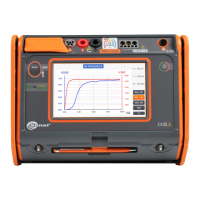Repeat the steps for two
additional locations of the voltage
electrode S:
located at a certain distance
from the tested earth electrode,
moved closer by the same dis-
tance to the tested earth elec-
trode.
This is done to confirm that the S
electrode was driven into the ref-
erence earth. If so, the differ-
ence between the value of R
E
between the main measurement
and each additional measurement
should not exceed 3%.
If R
E
measurement results differ
from one another by more than
3%, the distance of the current
electrode from the earth electrode
being tested should be consid-
erably increased and the meas-
urements should be repeated.
WARNING
Measurement of resistance-to-earth may be carried out if voltage of interfer-
ences does not exceed 24 V. Voltage of interferences is measured up to the
level of 100 V.
Over 50 V it is signalled as hazardous. The meter must not be connected to
voltages exceeding 100 V.
It is recommended that the test earth electrode as well as H and S electrodes
should be located in one line. Due to the different field conditions it is not always
possible. On the website manufacturer’s website and in professional literature spe-
cial cases of probes location have been discussed.
Use C-3 clamps for the measurement.
Maximum interference current: 1 A.
Particular attention should be paid to quality of connection between the object being
tested and the test lead – the contact area must be free from paint, rust, etc.
If resistance of test probes is too high, R
E
earth electrode measurement will in-
clude an additional uncertainty. Particularly high uncertainty of measurement oc-
curs when a small value of resistance-to-earth is measured with probes that have a
weak contact with earth (such a situation occurs frequently when the earth electrode
is well made and the upper soil layer is dry and slightly conductive). Then, the ratio
of resistance of the probes to resistance of the tested earth electrode is very high
and consequently, uncertainty of measurement that depends on this ratio is also
very high. Then, in accordance with the formulas from section 10.3.4, calculations
can be made to estimate the influence of measurement conditions. To reduce the
uncertainty of the δ, measurement, the contact of the probe with earth may be im-
proved, for example, by:

